The band mutation in Neurospora crassa is a dominant allele of ras-1 implicating RAS signaling in circadian output
- PMID: 17575051
- PMCID: PMC1891427
- DOI: 10.1101/gad.1551707
The band mutation in Neurospora crassa is a dominant allele of ras-1 implicating RAS signaling in circadian output
Abstract
band, an allele enabling clear visualization of circadianly regulated spore formation (conidial banding), has remained an integral tool in the study of circadian rhythms for 40 years. bd was mapped using single-nucleotide polymorphisms (SNPs), cloned, and determined to be a T79I point mutation in ras-1. Alterations in light-regulated gene expression in the ras-1(bd) mutant suggests that the Neurospora photoreceptor WHITE COLLAR-1 is a target of RAS signaling, and increases in transcription of both wc-1 and fluffy show that regulators of conidiation are elevated in ras-1(bd). Comparison of ras-1(bd) with dominant active and dominant-negative ras-1 mutants and biochemical assays of RAS function indicate that RAS-1(bd) displays a modest enhancement of GDP/GTP exchange and no change in GTPase activity. Because the circadian clock in ras-1(bd) appears to be normal, ras-1(bd) apparently acts to amplify a subtle endogenous clock output signal under standard assay conditions. Reactive oxygen species (ROS), which can affect and be affected by RAS signaling, increase conidiation, suggesting a link between generation of ROS and RAS-1 signaling; surprisingly, however, ROS levels are not elevated in ras-1(bd). The data suggest that interconnected RAS- and ROS-responsive signaling pathways regulate the amplitude of circadian- and light-regulated gene expression in Neurospora.
Figures
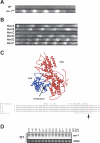

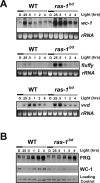
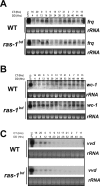
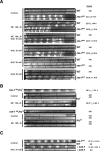
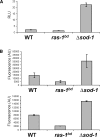

References
-
- Aguirre J., Rios-Momberg M., Hewitt D., Hansberg W., Rios-Momberg M., Hewitt D., Hansberg W., Hewitt D., Hansberg W., Hansberg W. Reactive oxygen species and development in microbial eukaryotes. Trends Microbiol. 2005;13:111–118. - PubMed
-
- Altschuler D.L., Muro A., Schijman A., Almonacid F.B., Torres H.N., Muro A., Schijman A., Almonacid F.B., Torres H.N., Schijman A., Almonacid F.B., Torres H.N., Almonacid F.B., Torres H.N., Torres H.N. Neurospora crassa cDNA clones coding for a new member of the ras protein family. FEBS Lett. 1990;273:103–106. - PubMed
-
- Aronson B.D., Johnson K.A., Loros J.J., Dunlap J.C., Johnson K.A., Loros J.J., Dunlap J.C., Loros J.J., Dunlap J.C., Dunlap J.C. Negative feedback defining a circadian clock: Autoregulation of the clock gene frequency. Science. 1994;263:1578–1584. - PubMed
-
- Arpaia G., Loros J.J., Dunlap J.C., Morelli G., Macino G., Loros J.J., Dunlap J.C., Morelli G., Macino G., Dunlap J.C., Morelli G., Macino G., Morelli G., Macino G., Macino G. The interplay of light and the circadian clock. Independent dual regulation of clock-controlled gene ccg-2(eas) Plant Physiol. 1993;102:1299–1305. - PMC - PubMed
-
- Bahn Y.S., Muhlschlegel F.A., Muhlschlegel F.A. CO2 sensing in fungi and beyond. Curr. Opin. Microbiol. 2006;9:572–578. - PubMed
Publication types
MeSH terms
Substances
Grants and funding
LinkOut - more resources
Full Text Sources
